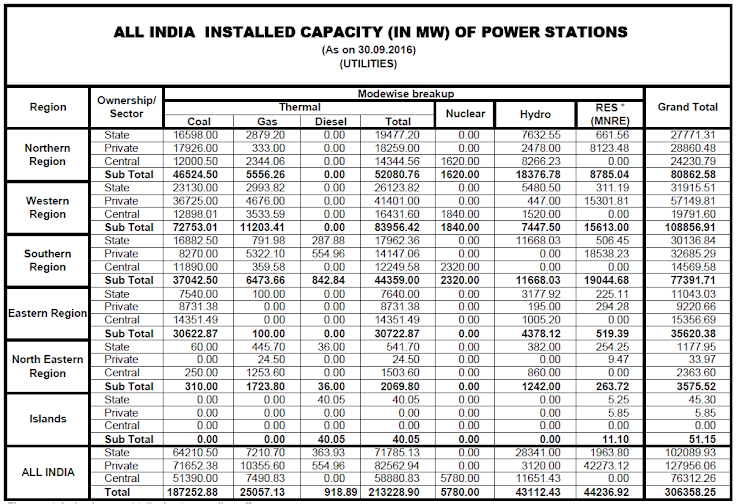Popularising energy-efficiency concepts among consumers can put India firmly on the path of sustainable development.India is poised to achieve a sustained economic growth rate of 8-9 per cent right up to 2031-32. This would require an increase in primary energy supply of three to four times the present level, according to Planning Commission estimates.
Fossil-fuel-driven energy sector growth, amidst emerging climate constraints, the uncertain availability of fuel and soaring fuel prices, could severely constrain the country's quest for energy security. That said, energy efficiency could be a key factor in moderating the demand for additional energy sources without compromising on energy availability.The Eleventh Plan (2007-2012) quantified, perhaps for the first time, energy efficiency as a resource in energy sector planning and targeted a 5 per cent reduction in consumption at end use. This is equivalent to 10,000 MW of avoided investments in thermal power plants amounting to Rs 50,000 crore.
The innovative policies and programmes of the Bureau of Energy (BEE), a statutory body of the Government of India under the Ministry of Power, have ensured that this target is likely to be exceeded. Encouraged by this achievement, the Twelfth Plan will initiate a thrust on low-carbon growth strategies fuelled by energy efficiency as a major resource.
ECONOMIC BENEFITS
The estimated medium-term potential for energy saving, as per the BEE's assessment, is of the order of 15 per cent, at a conservative level. This could potentially reduce the need for additional capacity addition of almost 100,000 MW from the 600,000 MW planned till 2030.The Government needs to herald innovative policy and regulatory measures that create and sustain an energy efficiency brand by a transparent mechanism of sharing economic benefits.
The BEE has focused on strategies and measures to ensure that the attractiveness of energy efficiency translates into their widespread diffusion and adoption. These measures centre on creating incentives to motivate the various stakeholders to gainfully engage in energy-efficiency based economic activities.
The efforts of the BEE have brought about a transition in some sectors, in particular the end-use appliance market, which is witnessing a transformation in favour energy efficiency.The effective one-to-five ‘Star' labels have provided the consumer a basis to make an informed purchase decision, taking note of the operating cost of the equipment over its lifetime.
EMPOWERING CONSUMERS
Such labelling information has empowered consumers to assess the life-cycle cost of various household energy consuming equipment (refrigerators, air-conditioners, fans, etc) and has made them appreciate the fact that the purchase value is only a fraction of the total cost they will incur over the lifetime of the appliance.
This recognition has enabled investments in energy-efficient equipment and the consumer is willing to pay a higher purchase cost as savings in electricity bills compensate for the higher cost over just one or two years.
Thus, while the ‘Star' label creates a brand of energy efficiency, the power saved generates the economic benefits.The same combination could, therefore, be used to promote equipment with much higher levels of energy efficiency than are available at present (also referred to as Super Efficient Equipment [SEE]).
Using similar methodology as that adopted for the BEE's energy efficiency programme, standards and informative labels for SEE could be developed. This could leverage the brand value created for the Star label.
Once this is done, modalities can be chalked out for securing, quantifying and sharing economic benefits. The ideal candidates for such savings are the electricity distribution utilities of States that are usually saddled with financial constraints as well as power shortages.Most of their expenditure goes for procurement of power, in particular expensive power at peak periods of the day (evenings, for instance).
SAVINGS IN PROCUREMENT
Any savings in energy demand could result in lower procurement at peak period and/ or an opportunity to provide additional power to commercial consumers. In both circumstances, the utility will be better off and, therefore, taking steps towards such a scenario is justified.
Setting aside incentives for deployment of SEE (such as ACs, refrigerators, fans, etc) that constitute a significant portion of the demand, makes eminent economic sense.
To illustrate the point, let us take the example of Delhi, where the utilities are procuring around 5,000 MW of power to meet the growing demand. If one lakh ACs are replaced by SEE ACs, the reduction in power procurement would be around 100 MW (or 250 crore units per year), presuming the increased efficiency of SEE to be 40 per cent over the existing.
At an average procurement cost of Rs 2 per unit for bulk power, this translates into an annual savings of Rs 500 crore. Such savings by the utilities could be shared with the consumers to enhance their willingness to pay for the higher incremental cost of super-efficient equipment.
This benefit-sharing approach, under the oversight of the regulatory process, could help create and sustain markets for SEE. The Star label brand could well be extended to SEE as well to leverage the brand value and acceptability of such equipment.
Utilities could provide incentives in the form of part subvention of the purchase cost of the SEE and the BEE could guide the utilities concerned and maximise the benefits to the country.
The combination of branding and sharing of economic benefits provides a mechanism to mainstream energy-efficiency. Innovations in programme implementation could help India become a hub of efficiency and embark on the path of sustainable development.


